Recently, while attending a Porsche press event at Road Atlanta, David Donohue was one of the lead-follow drivers, and we were very excited for the opportunity to meet him. He had a little bit of time during the lunch break, so we sat down for an impromptu discussion about life, his career, his father, and his current work with Porsche. It was a great time, and we’re grateful that David took the time to talk with us. It was a nasty rainy day at Road Atlanta, so we took refuge in a nice new 911 Turbo and cranked up the seat heaters for a lovely conversation.
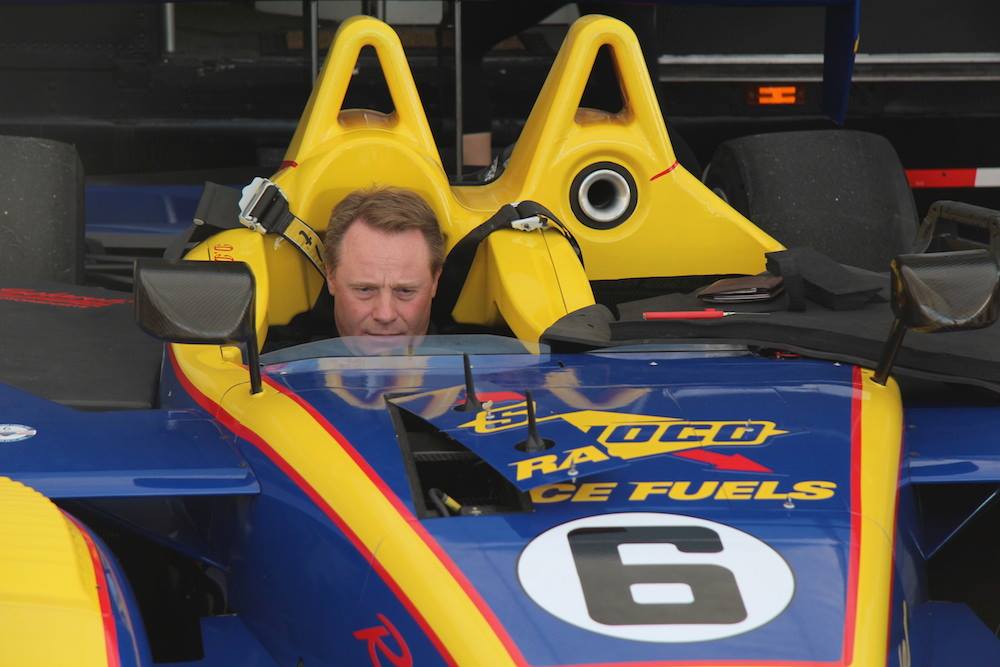
FLATSIXES.com – Thanks for joining us David. I thought I’d start off with this photo that I took at Rennsport Reunion a few weeks ago of you in the RS Spyder. It reminded me of a similar photo that I’d seen of your father at the wheel of the 917/30. So I’m forced to ask, does “resting bitch face” run in the family?
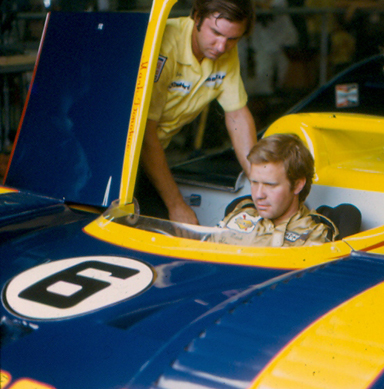
David Donohue – (Laughs) I don’t know how to answer that. I guess so.
FS – Just lightening things up with a quick joke. So what is your current title in your work with Porsche, and how is that going?
DD – “918 Client Relationship Manager”. It’s going really well, but it’s a real job. When a racing driver tells you he has a real job, that’s nothing compared to actually having to work.
FS – So earlier we were talking about your 20 year plus career in sports car racing. What moment from that span sticks out to you as most important? Is it a Daytona 24 hour victory? Is it going to Le Mans?
DD – Yeah, I’m sure. The Rolex 24 in 2009 was definitely a highlight. It was a pretty dramatic race. It was under Brumos colors. Bob Snodgrass, who meant so much to me, wasn’t there for it. Bob Carlson had just passed away, who was Porsche’s director of public relations, and a dear friend since the early 1990s. Hurley was there, although as much as I tried and tried and tried to get him in our car in some manner, they didn’t do that. If he’d been with us, that would have been his 6th win, even if he’d drive for just 20 minutes or something.
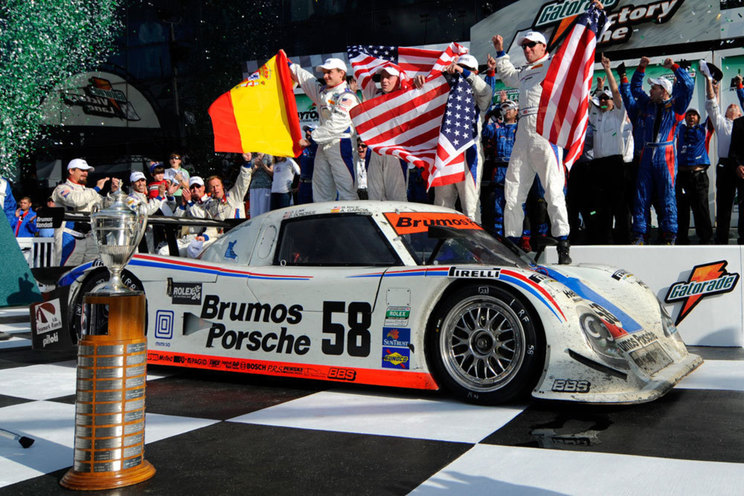
FS – And that would have given an even higher target for Scott Pruett to reach.
DD – (Chuckles) Yeah, and for me it’s just a badge of honor that we’ve been friends for so long. He [Hurley] was really good friends with my dad, which a lot of people don’t realize.
FS – It’s great that you guys both get to work together, because you’re both here today as instructors at Road Atlanta for this GT4 and GT3 RS press launch. It was funny, I was following his lead in the GT4s and you were leading a group of GT3 RS around the track, and we caught up to the tail end of your group, and..
DD – Oh, I’m sure he had something to say about that. (Laughter)
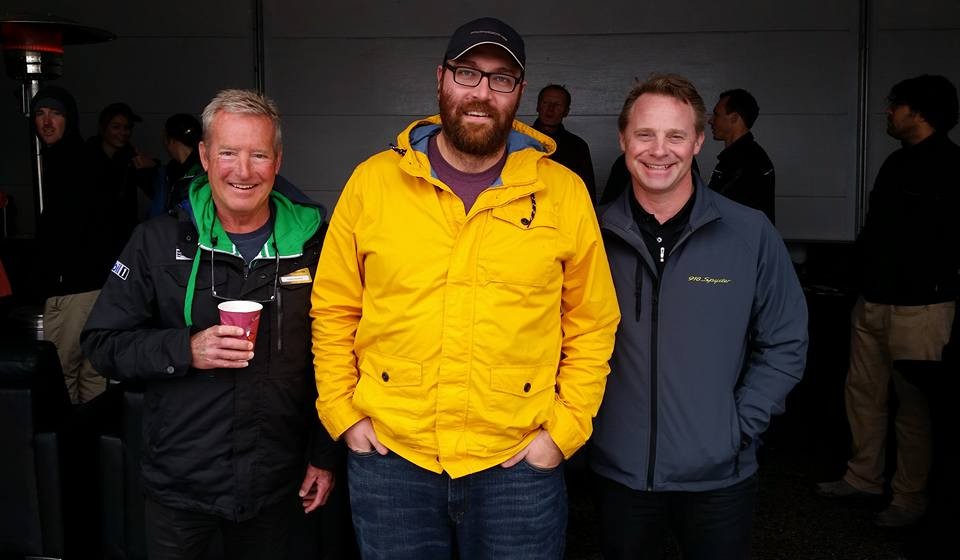
FS – He got out with a big smile on his face and said “You guys can be proud of yourselves!”. I asked him if he had an under-the-table bet going on with you on which group would be faster.
DD – I think some people are just intimidated by the GT3 RS, because it’s actually a much, I think, an easier car to drive in the wet, but people just aren’t getting on it down the straights, and they’re really timid. It seems like people are ready to slide the GT4 everywhere.
FS – I really liked the GT4. I think it’s a great platform. It handled really well for me. And I really liked these tires, I think they handled this treacherous weather quite well. I don’t think any of the competition from outside of Michelin, probably would not have been able to handle it as well.
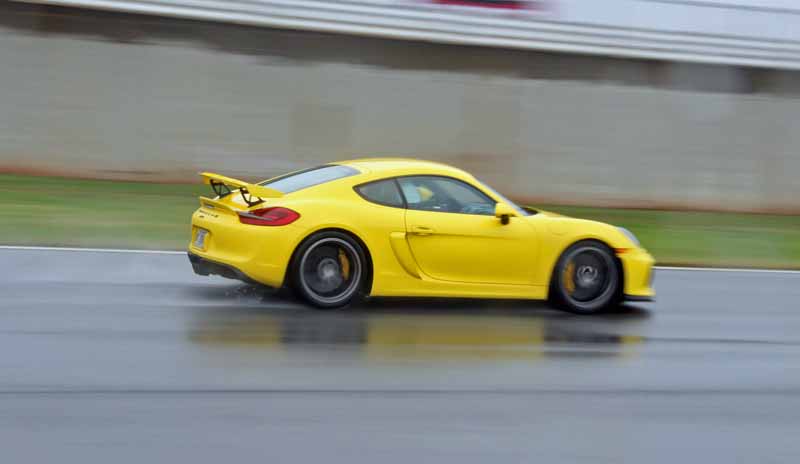
DD – It’s surprising when you read the literature on the Sport Cup 2. It makes you fear the wet, avoid it like the plague. It’s really, it’s not that bad. We learned that, because it’s a Sport Cup 2 on the 918, and I’ve driven that an awful lot in the wet, and never really seemed to have an issue beyond what you would normally expect from a regular tire. They don’t do as well in cold conditions, because it’s an ultra high-performance tire, but all of the tire manufacturers have that same issue.
But yes, I agree. I think the GT4, I drove it on the street yesterday, and for me it had striking similarities to when I drove the ’67 ‘Around the World’ car from Monterey a couple of years ago. I drove that with Vic Elford on the parade at Monterey. I was really worried, because I hadn’t driven a 901 gearbox in I don’t know how long, and here’s Vic Elford who has every upshift and downshift is naturally perfect. He’s heel-toeing and you don’t even know he’s doing it. If you know Vic, he can be pretty judgemental right out of the box, and once he passes judgement, that’s it for the rest of his life. So I knew I was going to have to drive with him in the car, and then I drove it, and the way the revs drop on the upshift is just a natural progression, and it came fluidly. So I found the GT4 to be very similar in that regard, the RPM drops just perfectly into place for the next gear. And the downshift, because you know it has the autoblip on downshifts when you’re in Sport+. I didn’t know it was when you were in Sport+ and I was just naturally heel-toeing, and it was really easy, and I was like ‘It can’t be this good, it can’t be this easy!’. Usually the first time you do it in a new car, it’s a little herky jerky just from my experience. And the GT4 was never herky jerky. So I just decided I was going to do a downshift without using the throttle, and it was immaculate. It was just the natural way the car was. So it’s really a pleasure to drive on the street, because it’s light and nimble and it just does a lot of stuff for you.
FS – Yeah! One of the, I don’t know if it’s a complaint, but some people have been saying that the gearing is maybe too tall. I didn’t really experience that, I mean 3rd will go to over 100 miles an hour, so I guess it is a little tall gearing.
DD – That’s tall? It felt kinda short. I mean you take the old 930s and first gear would go to 60. A lot of our race cars will do 100 in first, so I’m sort of used to that. I’d have to look at the gear drops, I haven’t actually looked at a gear chart on a GT4, but Porsche tends to, especially on a car like that, tends to create a car that matches a variety of scenarios instead of just one. So you can never pick one criteria to measure it by. I’ve had so much time with the 918, and it’s always compared to the LaFerrari and the P1 that have more power and have ridiculous accelerations at high speed. The truth is, the 918, like every Porsche, is designed to be driven as a normal car would be driven, even on the race track. Not many race tracks have a top speed over 150, let alone over 180 or 200. So it was really designed to run at those more common speeds.
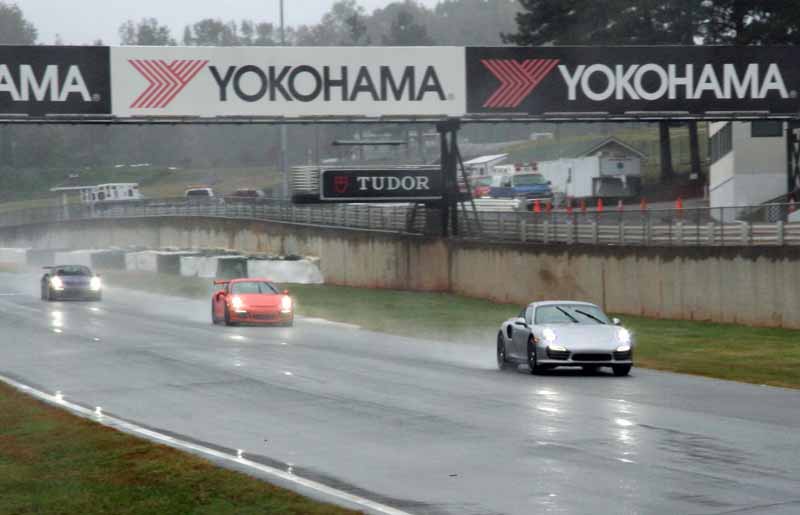
FS – So over the span of your career, this is a two-fold question, what was the best car that you drove, and what was the best team that you drove for?
DD – Oh man, that’s an unfair question. I would say the best team I can’t answer, for sure, because I spent almost 10 years with Brumos, and later when it was Action Express, which was still sort of the same team but a bit different. I would say that team changed quite a bit when Bob Snodgrass passed away, and then Hurley kind of stepped away, and Brumos did their own GT effort, so there was a lot of change even in those Brumos years. Dramatic changes in the alignment of the racing series’, within the team itself. I mean, there’s a constant adaptation going on. Plus we had a car that wasn’t really up to the competition for a lot of those years, using an original DP car.
I would say when I was with Oreca, I didn’t appreciate what they were doing, and their abilities, nearly as much as I do today. I was sort of a bit of a spoiled brat on that car, as the token American, not realizing how well that they not only executed with the Viper, but also executed on behalf of a manufacturer, and carried that flag for that car and the brand.
Before that, it was Pac West. Pac West was an Indy Car team, and Dominic Dobson was running it. I’ve just been really lucky to be in some really top notch teams. A variety of them. Before that I was with BMW, and that was more of a fledgling effort being thrown in Tom Milner’s lap after it was a private effort and run by the Prototype Technology Group. He kind of got thrown into the fire on that one, and the car came over and it was really not built that great for the series. We really had to redevelop it all. By the time I left for Pac West, they were really getting their legs under themselves.
As far as best car, again, I would probably go back to that 2009 Daytona race. We were supremely confident going into that race. I had had shoulder surgery that winter, and Darren Law my team mate had done all of the testing because I couldn’t drive with my shoulder. And by the time I got in the car, we had very little more development to do. We had a lot of experience from years before. Joe Lajoie was the engineer. He had a really solid understanding of what was required there, with that body, because it was a dated body. Everyone else had that new bodywork.
While the car was definitely strong in the straights, it never lacked on the infield either. People forget that, because I never really bowed the Ganassi car’s attempts to divebomb me on the infield. They were just giving up speed on the infield. Everyone kept saying “Oh, well he’s gaining so much on you going into the corners, and you’re killing them coming out“. Sorry, but if you apex early in every corner, I’m going to kill you coming out. That’s all that was really happening. He was trying to make up ground where he thought he could, and I knew that he wasn’t going to make up that much ground and I could make it up on the exit of the corners, and he’d just have to try it again, and it just kept repeating.
That car could drive anywhere on the race track. I could go through the worst dirt. It felt like I would have no loss of grip if I were to go through the grass. It was a solid car, and it was in decent shape. Mechanically it was in great shape.
FS – Why is it, do you think, that so many of the top prototype teams have drifted away? It seems to be every week, there’s only four or five that show up. At the height of Grand Am, I mean I remember one Daytona race where 65 cars would show up and almost 30 of them were Daytona Prototypes.
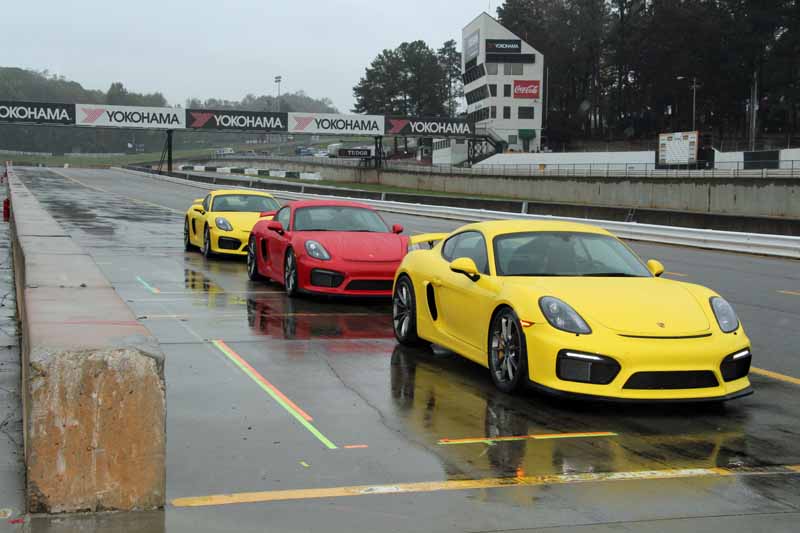
DD – I think the DP category made sense when it was all DPs. The pricing got a little bit crazy. The original vision was an affordable car that would last a long time and was repairable. The engine wasn’t an integral member to the chassis, so you could change engines. But it really strayed away over time. The axles were obsenely expensive. A lot of little bits and pieces became really expensive. And unfortunately you see this a lot today, the competition is being managed from the tower, rather than from the track. So if there is one car that is maybe inadequately designed, then they throw them a bone to make them competitive. So the guys that actually did all their homework and did the hard work say ‘Well why did we work so hard? All we have to do is run poorly the one year, and they’ll give us everything we need for the next.’ So it kind of loses its logic, and now they’re trying to balance a P2 versus a DP car on completely different build philosophies, lap times, even if they’re similar, they’re being acquired in very different ways. The DP car is a bit antiquated in comparison to a P2 car.
I can’t imagine Prost and Senna going at it with ‘stop and go’ and ‘avoidable contact’ penalties.
I drove an RS Spyder at Rennsport this year, and it was just the nicest car I’ve ever driven. I mean, I’ve never raced it, but that was an older spec P2 car. It gives the driver so much feedback, and it made you look like a hero the way you could outbrake people. And from inside the cockpit it’s not a big deal. I still think a lot of things these days are underpowered. When I started racing, race cars had more power than road cars. There were no penalties on the track. Racing has changed a lot. I can’t imagine Prost and Senna going at it with ‘stop and go’ and ‘avoidable contact’ penalties.
FS – So where do you see things going? I mean, even GT3 class cars are getting to a point where it’s the same thing that happened to GT2 and GT1 even. GT1 got so expensive that it was only Corvette in that class, and that went away. Then GT2 became GTE, and now GTE is pretty much all manufacturers and it’s very expensive for privateers. And now GT3 has been the place for privateers, but that’s getting expensive and manufacturer teams are showing up there. I mean, you have half-million dollar GT3 class cars.
DD – I mean, the half-million dollars, I don’t think that’s the hurdle that’s really hard to get over. I mean, there’s a million dollar road car sitting right over there. If the car cost a half-million dollars, there has to be justification for it. It should be durable enough to run a 24-hour race or something. The engine life should be significant. The maintenance should be minimal. Service-ability should be easy. There needs to be some things to come along with it. And GT3 class racing is big enough that you have to assume that once a car becomes obsolete, there has to be a place for those year old cars or two year or three year old cars to go. So that investment of half a million dollars, doesn’t mean it’s worth zero at the end of a first or second season.
I think, to me, World Challenge has really been in the catbird seat for a while as far as regulation. I think what Jeff Carter had done with it, bringing in all of those GT3 cars early on. Because it’s cost prohibitive for an individual to build a race car these days. When you have the manufacturer building one and they’ve got North America and Europe and Asia and the Middle East where they can sell it and market it, then it makes a little bit more sense.
FS – Okay, so we’ll end on a story. What is a something that you’ve done that was exciting for you.
DD – What’s exciting for me is probably going to be insomnia curing for the rest of the world! (laughs)
I think back in 2000 at Le Mans, it was Viper vs. Corvette and it was just god-awful hot. And guys were getting out and passing out. We didn’t win, but I was particularly proud of not just my performance, but the performance of our team. Corvette was really putting pressure on, and the team boss goes “Alright, we’re going to want you to go flat out for a double stint” and I looked at him and said “Are you nuts? A double stint? There’s guys passing out after an hour. I’ll go flat out, but I can’t promise a double stint.” By that time, we knew there were issues with the heat. In that car, even the coolest day, it was around 142 degrees in the car. I remember at one point, we had the air injection in the helmet and I thought “this system must not be working“, so I opened my helmet visor, and the heat wave that hit my face, it just blew my mind that it could actually be hotter outside than it was in my helmet. I was putting my hand out the window to duct air inside. I was really lucky, because when I get heat fatigue, I’m affected in my eyesight before anything else. The good thing about that is some people start to get silly and lose their sense of logic, but because I see it in my eyes, I can consciously recognize what is happening and take appropriate steps to not get beyond that. I made up huge ground on the Corvette. And I did something similar at Daytona, maybe that same year. I was really proud of those drives, but they went largely unnoticed.
There was one drive that was really satisfying that went totally unnoticed at the 6-hours of Watkins Glen in rainy conditions, and the windshield fogged. My dad wrote in his book that the last thing he wanted to do was pit because of fogged up goggles. And he struggled once at Laguna Seca because all of a sudden he couldn’t see. He was embarrassed because before that race started, Karl Kainhofer had said to him “We love you Mark, because you don’t pit for stupid reasons like fogged up goggles“. And I don’t know why that stuck in my mind before that race, and we were under yellow flag very early because it was raining, and someone on the radio said “Is everything alright? How’s visibility?” and I replied “Everything’s great! Visibility is perfect!” and I swear as soon as I keyed off, it started fogging the windshield. I just said it was okay, I can’t go back on that, as soon as we get going, maybe it’ll clear up. And it got really bad and I had to pit. And it was one of those things where it was like my dad’s voice was in my head. You never know what the crew is going to say. “I can’t believe you pitted for something so stupid. It’s not that bad.” and what makes it worse is that I went back out and it happened again! So I had to pit under green and fell way way back. And I had to charge from the back of the pack and got back to the front. I overtook everyone on the track, including the lead DP cars. Everyone thought the track was drying and I was on slicks, but I wasn’t. I was on the same tires everyone else was on. And it happened in that window for the race that was not on TV. So it was after the first two hours, but before the finish. So when it went away, I was so far back I wasn’t even part of the broadcast. I was a lost cause. Then it goes off TV and I mount a charge to lead the race, and by the time we came back on, the car wasn’t very good when it dried out, and we fell back further. We completely missed the limelight just by the time it came back on air, we were out of the race again. A lot of those really good drives, and I’m sure I’m not alone, I think every driver has these exceptionally proud drives that nobody ever sees.
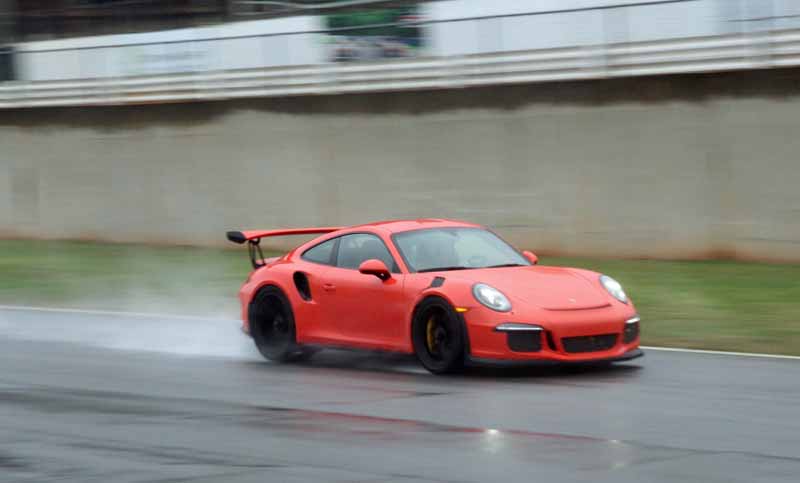
FS – Well that’s the interesting part of getting to talk to people like you, is being able to hear those stories! We really appreciate you taking the time, and thank you for sitting with us for a little while. I think the track is about to get started back up for the afternoon sessions, so you’ve got to get back to work!
DD – Well, it’s warmer in here with these heated seats! Thank you! Pleasure’s all mine.
